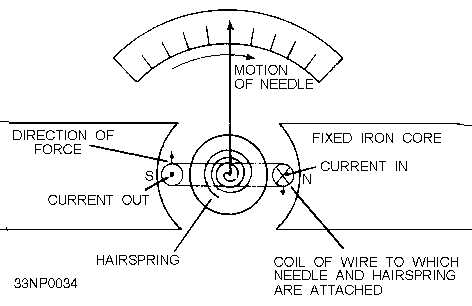3-4
Figure 3-2.—D'Arsonval meter movement.
In the figure, only one turn of wire is shown; however, in an actual meter movement, many turns of
fine wire would be used, each turn adding more effective length to the coil. The coil is wound on an
aluminum frame (bobbin) to which the pointer is attached. Oppositely wound hairsprings (only one is
shown in the figure) are also attached to the bobbin, one at either end. The circuit to the coil is completed
through the hairsprings. In addition to serving as conductors, the hairsprings serve as the restoring force
that returns the pointer to the zero position when no current flows.
Q-5. What component of the D’Arsonval meter movement completes the circuit for current flow to the
coil?
COIL MOVEMENT.—As we discussed previously, the deflecting (moving) force on the coil is
proportional to the current flowing through the coil. This deflecting force tends to cause the coil to rotate
against the restraining force of the hairsprings. When the deflecting force and the restraining force are
equal, the coil and the pointer stop moving. As we have just stated, the deflecting force is proportional to
the current in the coil, the angle (amount) of rotation is proportional to the deflecting force; therefore, the
angle of rotation is proportional to the current through the coil. When current stops flowing through the
coil, the deflecting force stops, and the restoring force of the springs returns the pointer to the zero
position.
Q-6. What component supplies restoring force to the coil of the D’Arsonval meter movement?
DIRECTION OF FORCE.—The current through the single turn of wire is in the direction
indicated in the figure (away from you on the right-hand side and toward you on the left-hand side). If we
apply the right-hand motor rule, the direction of force is upward on the left-hand side and downward on
the right-hand side; therefore, the direction of motion of the coil and pointer is clockwise. If the current
were reversed in the wire, the direction of motion of the coil and pointer would be reversed. For a review
of the right-hand rule for motors, refer to NEETS, Module 5, Introduction to Generators and Motors.
PRINCIPLE OF OPERATION.—A more detailed view of the basic D'Arsonval movement, as it is
used in ammeters and voltmeters, is shown in figure 3-3. The principle of operation is the same as that
discussed in the simplified version. The iron core is rigidly supported between the pole pieces; it serves to

